Physical Address
304 North Cardinal St.
Dorchester Center, MA 02124
Brainstem reflexes are relatively simple motor responses organized by the brainstem and designed to enable the body to adjust rapidly to sudden changes in the environment.
The laryngeal adductor reflex (LAR) is possibly one of the most crucial of all brainstem reflexes because of its life-sustaining, pivotal role in airway protection. The LAR protects the airway from potentially life-threatening aspiration by causing vocal fold adduction and thus laryngeal inlet closure with tracheobronchial tree protection.
The importance of the LAR for survival explains many of the characteristics of this reflex. It is robust, resilient to specific general anesthetic agents, and takes precedence over other motor behaviors such as respiration, and speech . The LAR is an independent self-governing motor behavior, triggered by afferent sensation from the supraglottic mucosa, allowing the protective function of the larynx to be entirely reflexive and involuntary .
Organizational models for the LAR in animals and humans have been proposed . Sensory information from supraglottic mucosa travels through the ipsilateral internal branch of the superior laryngeal nerve (iSLN) and vagus nerve to the nucleus of the solitary tract, where bundling afferents from different cranial nerves run rostral or caudally along the length of the nucleus. From the nucleus of the solitary tract, fibers project to the ipsi and contralateral nucleus ambiguous which runs the length of the ventrolateral part of the medulla buried within the reticular formation . The reticular formation is an essential structure that runs the entire length of the brainstem. The caudal reticular formation of the pons and medulla comprises nuclei and groups of local circuit interneurons that, among other functions, generate motor patterns and coordinate reflexes. The laryngeal motor neurons are located in the nucleus ambiguous . These efferent neurons travel to the larynx via the vagus nerve and its recurrent laryngeal (RLN) branch to the laryngeal musculature ( Fig. 15.1 ).
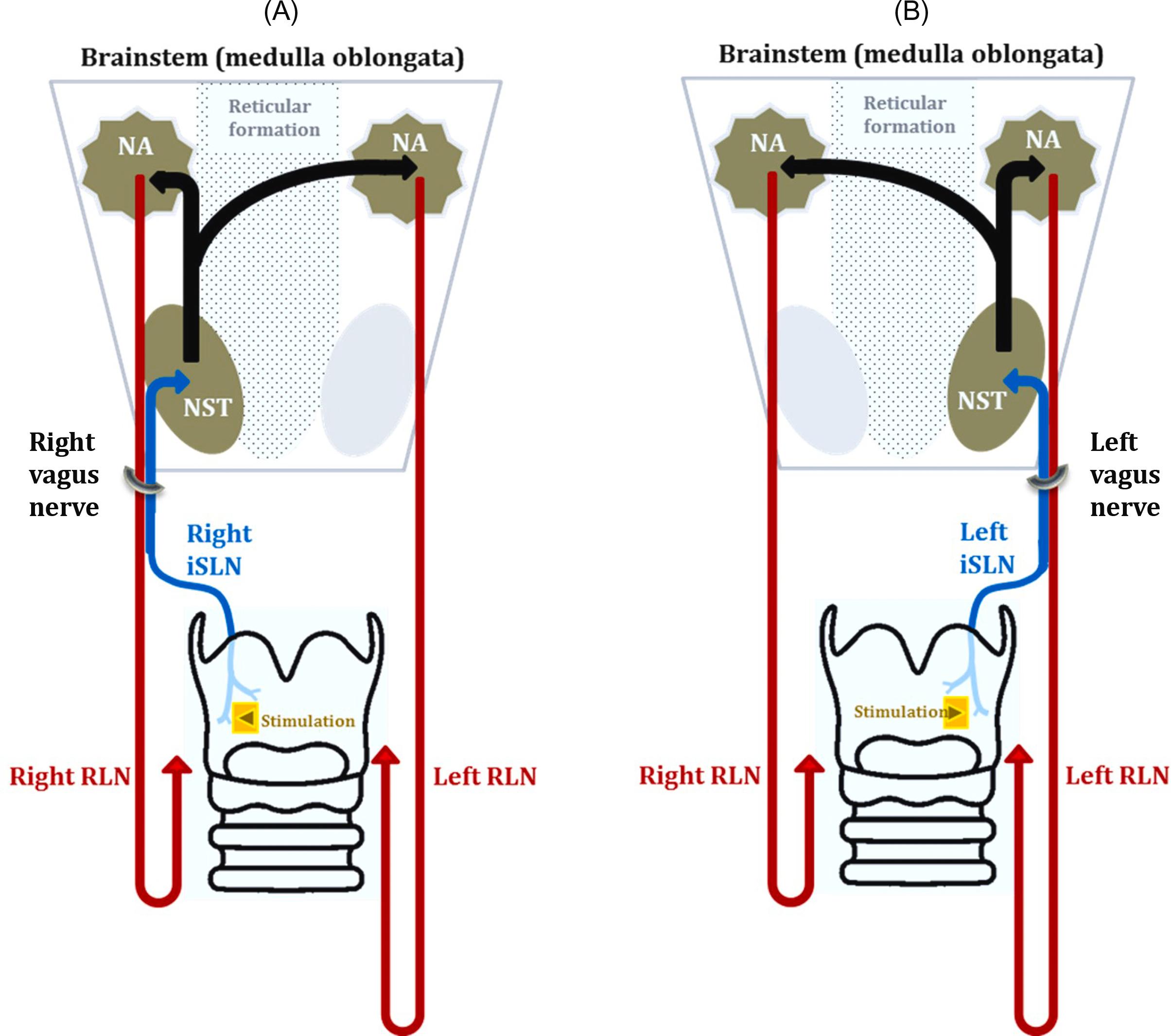
All laryngeal muscles are innervated by the RLN, except the cricothyroid muscle, which receives its innervation from the external branch of the superior laryngeal nerve. Vocal fold adduction results from contraction of thyroarytenoid and lateral cricoarytenoid muscles (main adductor forces) and interarytenoid muscles (closing the posterior gap of the glottis) .
Ipsilateral adduction of one vocal fold alone does not close the glottis or provide effective lower airway protection, predisposing the individual to aspiration . Thus, for the LAR to achieve effective glottis closure and airway protection, it needs to produce rapid, bilateral vocal fold contraction.
In this chapter, we revisit the function of the LAR and discuss groundbreaking new physiologic principles that have come to light in recent studies on awake subjects and patients under general anesthesia . We also describe a comprehensive, noninvasive, endotracheal tube-based methodology for the intraoperative monitoring of the vagus nerve using the LAR. This methodology has the potential to advance and change the intraoperative continuous vagal and laryngeal nerve monitoring. We also address the benefits, technical challenges, current limitations, and future directions for monitoring using the LAR.
Compared with nonhuman primates, the larynx of humans sits lower in the neck allowing for a pharyngeal cavity to exist above the laryngeal structure . Although this cavity helps humans to obtain the resonances that characterize human language from nonhuman primate vocalization, it also enhances the potential for aspiration of foreign substances into the tracheobronchial system. As such, humans require advanced laryngeal protective mechanisms to ensure that their lower airways are not threatened by the entry of foreign materials.
Over the past two decades, the LAR has been extensively studied in anesthetized animals (including cats, dogs, and pigs) and awake and anesthetized humans . The type of stimulus for LAR activation used in these studies has varied from direct electrical iSLN stimulation to air puff or electrical stimulation of the laryngeal mucosa .
Until very recently, it was thought that the LAR in awake humans consisted of an early ipsilateral component (relative to the stimulus), termed ipsilateral R1 (iR1), and late bilateral R2 component, termed ipsilateral (iR2) and contralateral (cR2) relative to the stimulus. Thus, it was concluded by past studies that the late, highly modulated R2 component must be the main contractile component of the LAR in humans because the iR1 was unable to provide adequate airway protection by virtue of its unilateral nature. In cats and humans under light general anesthesia with low mean alveolar concentrations (MAC) of inhalational agents, an additional contralateral R1 (cR1) component was documented by one group. In this study, both iR1 and cR1 occurred at ≤1 MAC, but the cR1 was abolished at higher MAC values . This led to the theory that the cR1 component is under supratentorial modulation which is abolished by general anesthetic agents; therefore it occurs under anesthesia but rarely in awake humans.
Recent studies from our team contradict this prior research and give evidence that the early R1 component of the LAR is bilateral in awake humans and patients under general anesthesia, consisting of an ipsi- (iR1) and contralateral (cR1) components relative to the stimulating side . This bilateral R1 component can be elicited at all depths of anesthesia in 100% of patients provided total intravenous anesthesia (TIVA) is used, and inhalational anesthetic agents and muscle relaxants are avoided.
The common theme across all our studies is that, despite different methodological approaches and consciousness states (detailed in Fig. 15.2 ), the R1 component of the LAR consistently appears as a bilateral response.
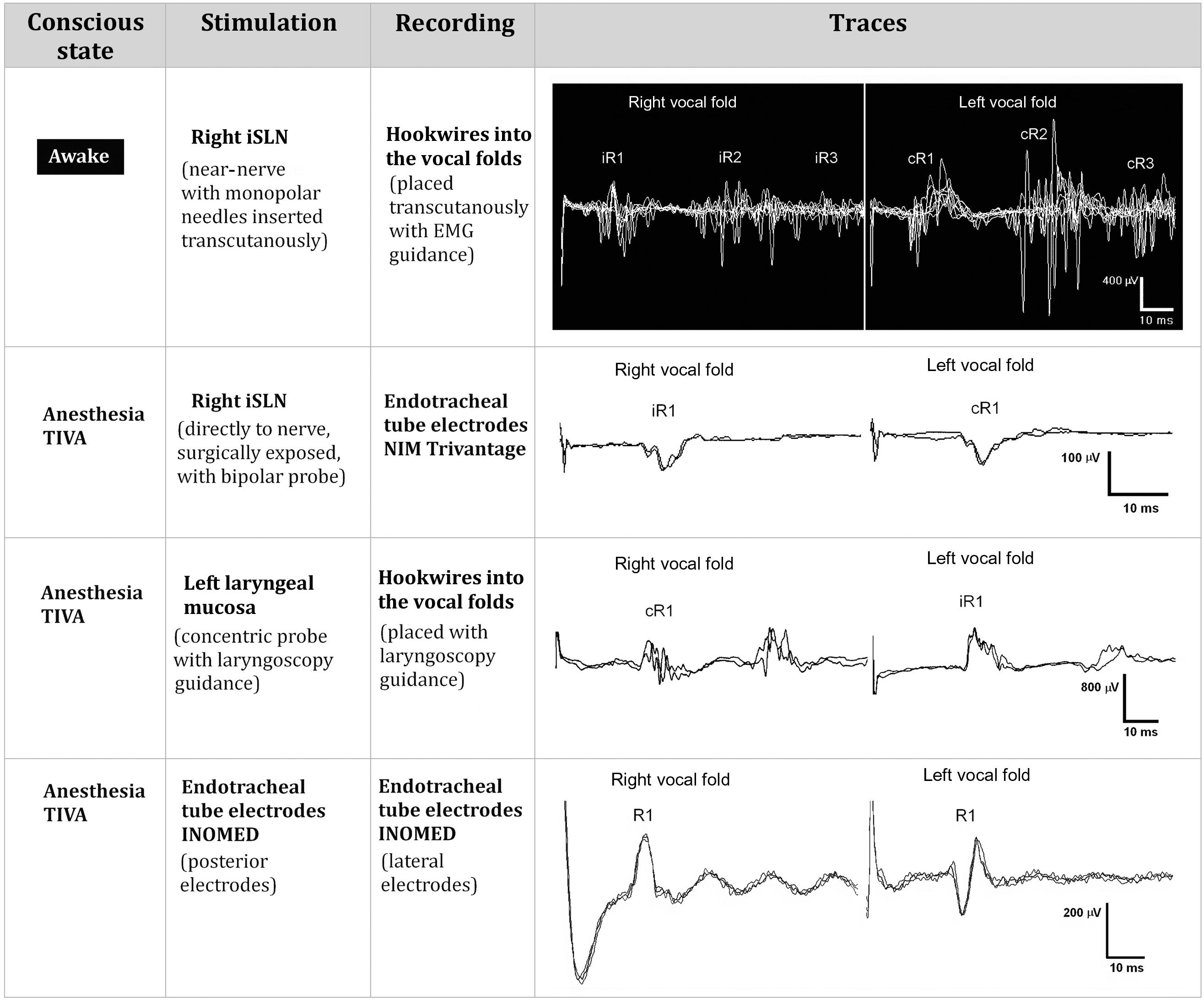
Similar to the cR1 component, prior reports investigating the LAR in humans under general anesthesia using inhalational anesthetic agents reported no discernable R2 responses at any level of the used anesthesia. Although we have observed R2 components in a subset of patients using TIVA, these responses are less reliable than the R1 component and frequently fade during the course of surgery. We have observed that inhalational anesthetic agents at increasing MAC concentrations and lidocaine (4%) topically applied to the laryngeal mucosa significantly decreases all components of the LAR when compared to TIVA, confirming that all components of the LAR are sensitive to certain forms of anesthesia ( Fig. 15.3 ) .
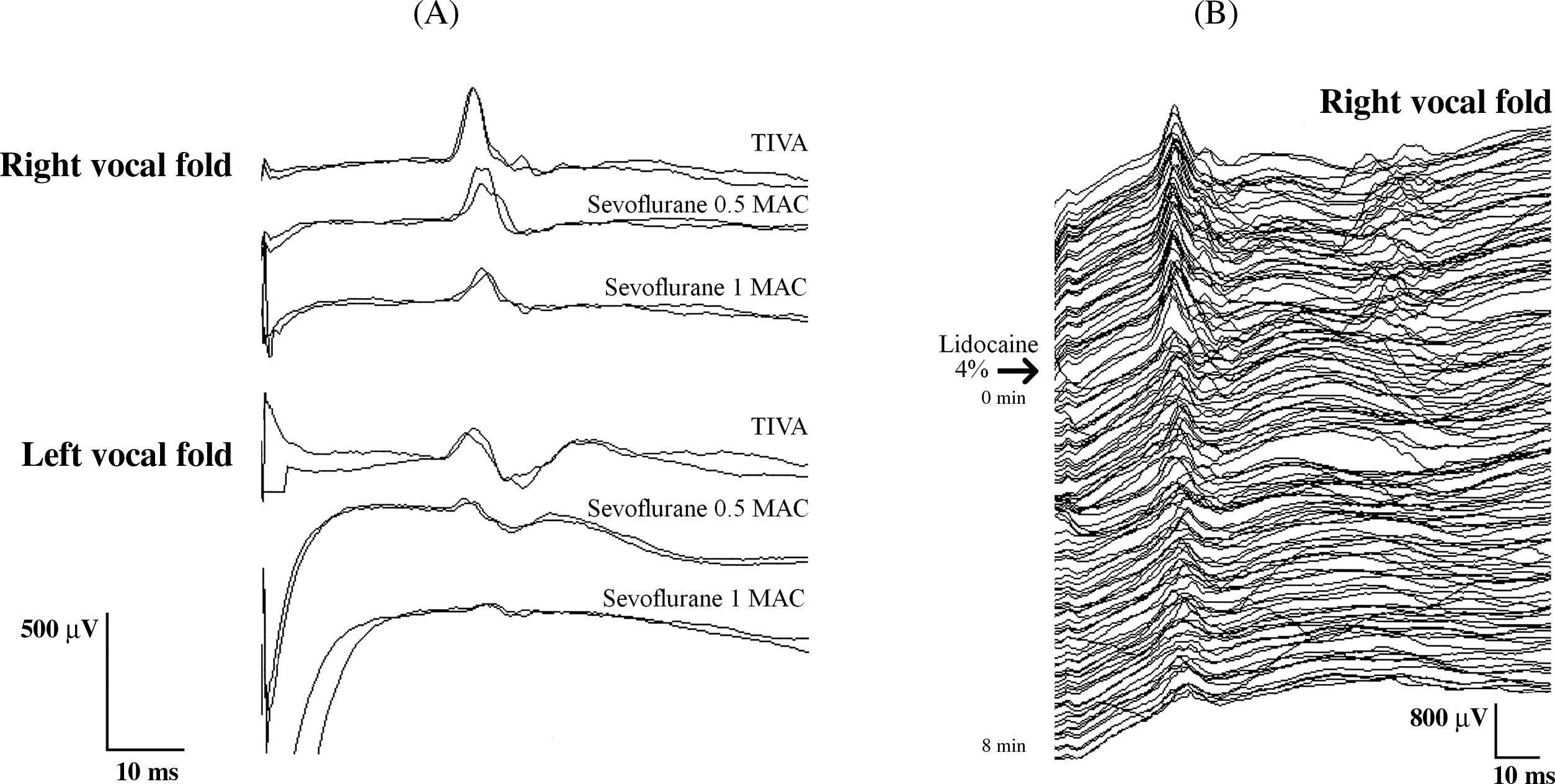
The cR1 component of the LAR can reliably be recorded during several hours of surgery without fatigue. Additionally, continuously repeated stimulation at 0.7–1 Hz for more than 90 seconds does not show habituation phenomena ( Fig. 15.4 ) allowing for frequent assessment of the LAR throughout the surgery.
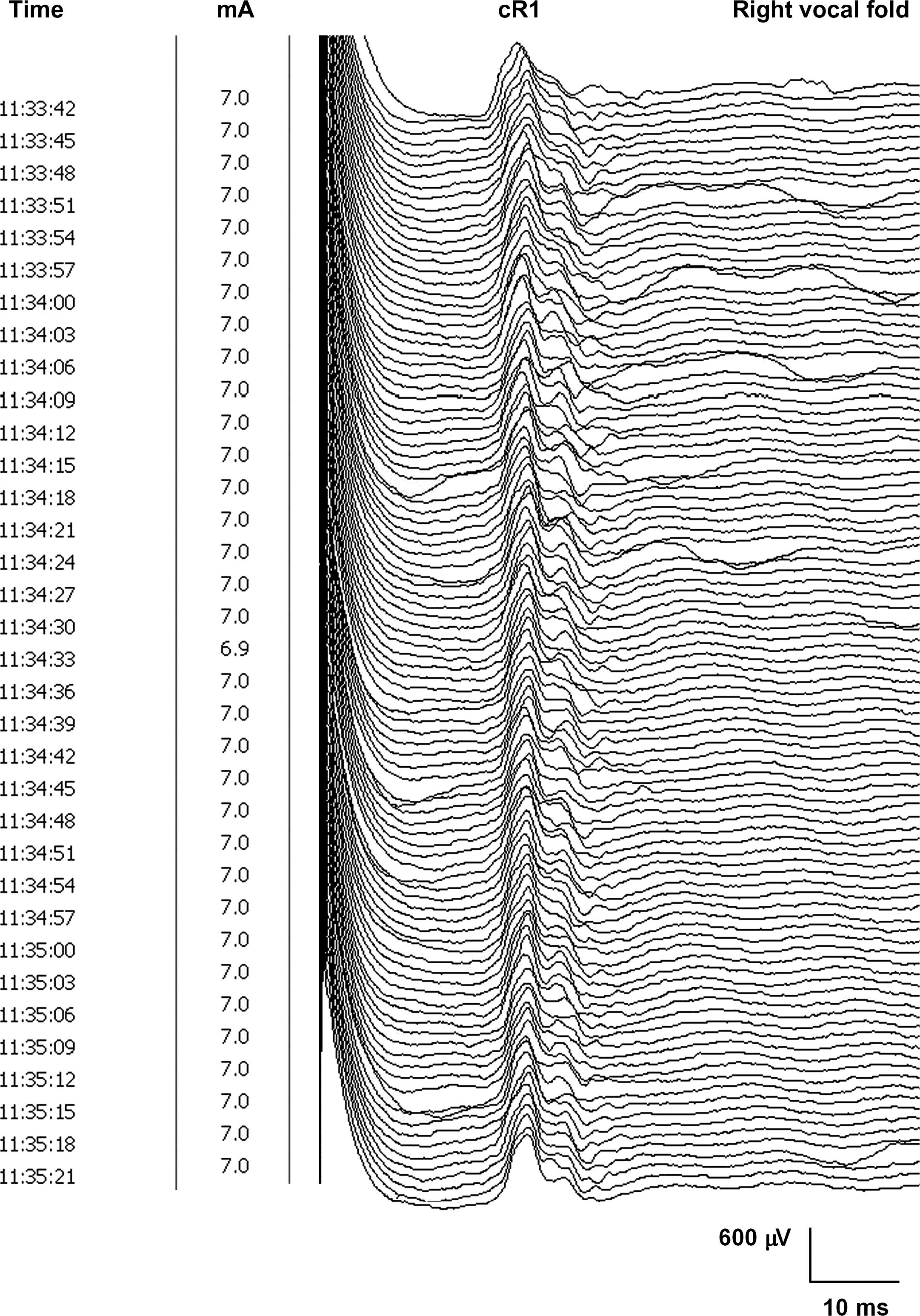
The discovery that a bilateral, rapid R1 component exists under general anesthesia which does not habituate nor decline under conditioning protocols and takes precedence over other motor behaviors , led us to hypothesize that this bilateral R1 response may play a greater role in airway protection than previously described. Thus, bilateral vocal fold adduction is probably not purely a function of the R2 component. If this hypothesis is correct, it follows that the ability of the human larynx to retain some protective function during states of altered consciousness with specific anesthetic agents could impact the choice of general anesthetic agent used, particularly for patients at high risk of aspiration during surgery.
The existence of a bilateral R1 component that endures under TIVA has been fundamental to the development of a noninvasive, comprehensive, new methodology that solely utilizes endotracheal tube electrodes to monitor cR1-LAR responses throughout surgery.
This new methodology has been primarily developed and evolved by monitoring the LAR during neck surgeries of endocrine glands (thyroidectomy and parathyroidectomy) where the RLN is at direct risk of injury due to its proximity to the operative field. However given the LAR is a complete reflex arc, its use applies to any surgery that places the vagus nerve or lower brainstem structures at risk of injury.
Anesthesia is induced with propofol and succinylcholine and maintained using TIVA with propofol and opioids (remifentanil). Patients are intubated using an endotracheal tube designed to monitor electrical activity generated by activation of laryngeal muscles. The endotracheal tube electrodes are attached or embedded on the surface of the tube. Table 15.1 summarizes the characteristics of different commercialized endotracheal tubes available from different manufacturers. In general, the endotracheal tube contains two surface electrodes on the right and left sides of the tube, that come into direct contact with the right and left vocal folds, respectively ( Fig. 15.5 ). After the patient is intubated and positioned for the surgical procedure, and before eliciting the LAR, the tube is rechecked using direct visualization with GlideScope Video Laryngoscope (Verathon, ULC, Burnaby, Canada) . The tube must be maintained in the midline to ensure accurate alignment of monitoring electrodes against the medial aspects of the vocal folds. Axial rotation of the tube or craniocaudally displacement above or below the level of the glottis will prevent optimal contact between the electrodes and targeted laryngeal structures and potentially disrupt recorded responses . Most of the available tubes have a radio-opaque or colored band that can be used for correct positioning. To achieve stabilization of the tube, we have found that an oral endotracheal tube fastener in addition to standard fixation with tape reduces intraoperative tube migration.
| Endotracheal tubes | COBRA | NIM EMG-ETT | NIM TriVantageTM | INOMED |
|---|---|---|---|---|
| Electrodes | ||||
| Type | Four conductive silver ink electrodes (two pairs) which are embedded in the endotracheal tube | Four stainless steel wire electrodes (two pairs) which are embedded in the silicone of the the endotracheal tube | Four conductive silver ink electrodes (two pairs) which are embedded in the polyvinylchloride (PVC) of the endotracheal tube | Eight adhesive electrodes constructed from medical-grade ink suspended in a polyester substrate |
| Location | Posterolateral | An anterolateral portion of the tube with a midpoint of approximately 10 cm above the caudal tip of the tube | Anterolateral electrodes placed at 11 cm above the caudal tip of the tube (proximal electrode) with a midpoint at 8 cm. Posterior-lateral electrodes placed at 9 cm above the caudal tip of the tube with a midpoint at 10 cm | Eight electrodes paced all around the tube with a midpoint approximately 9 cm above the caudal tip of the tube |
| Distance between balloon and midpoint of the electrodes | 4.5 cm | 3.5 cm | Proximal electrodes: 5.5 cm | 3 cm |
| Distal electrodes: 3 cm | ||||
| Surface area for each side | 3 mm wide×66 mm long | Two wire (0.2 mm) exposure of 29 mm each | Two surface electrodes of 24×4 mm (proximal) and 30×4 mm (distal) | Eight electrodes of 27×3.5 mm each |
| Guidance electrode position | Blue radio-opaque band marking the 3 cm electrode wire exposure | Blue radio-opaque cross-band | Anterior band | |
| Tube | ||||
| Material | PVC | Silicone elastomer | PVC | Polymer film covered by an insulating coating that is attached to a regular endotracheal tube |
| Reinforced | No | Yes | No | No |
| Inner/outer diameter | 6.0 mm/ | 6.0 mm/8.8 mm | 5.0 mm/6.5 mm | NA |
| 7.0 mm/ | 7.0 mm/10.2 mm | 6.0 mm/8.2 mm | ||
| 8.0 mm/ | 8.0 mm/11.3 mm | 7.0 mm/9.5 mm | ||
| 8.0 mm/10.7 mm | ||||
| 9.0 mm/12.0 mm | ||||
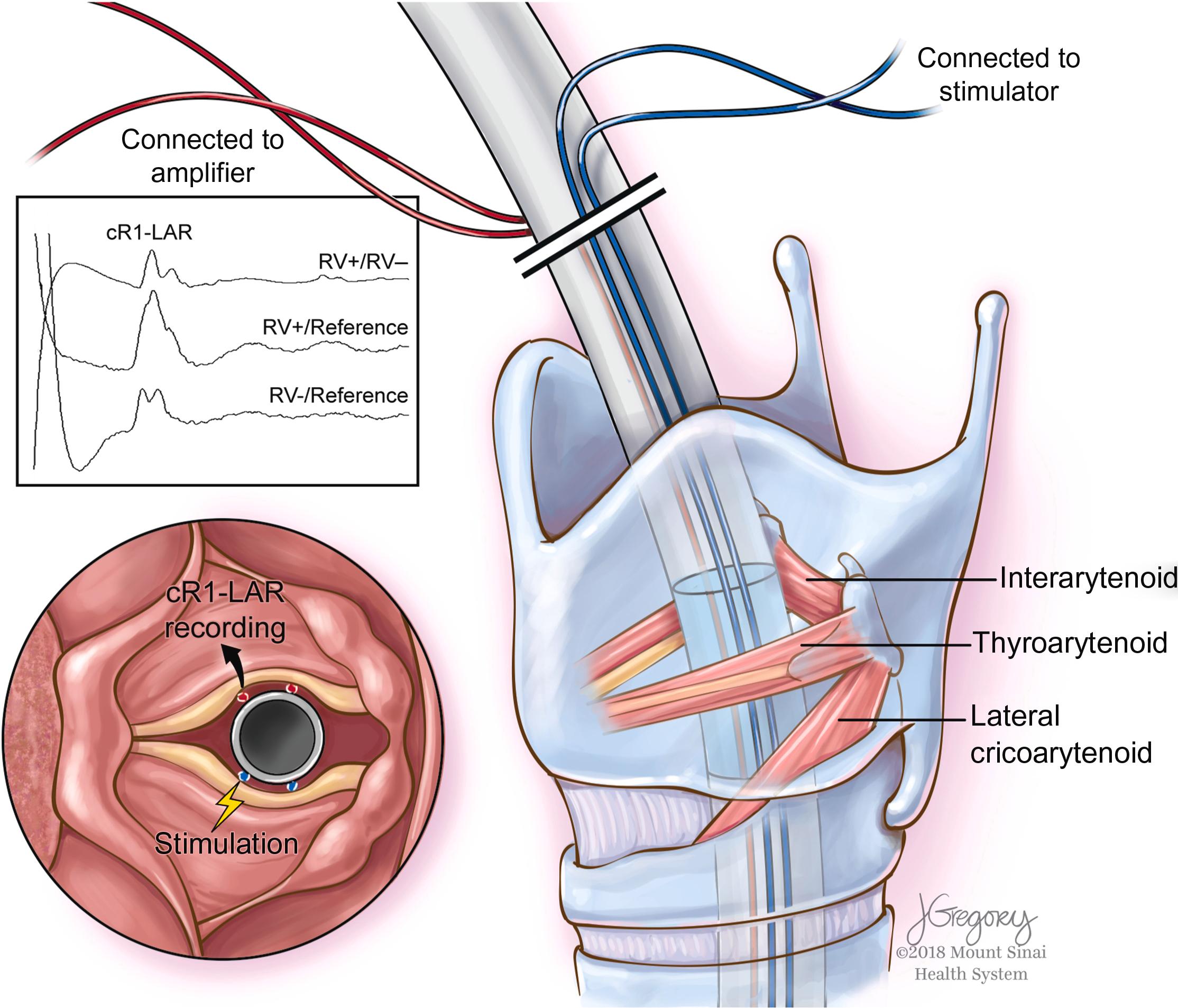
One important key to success is to choose the correct endotracheal tube size. This choice is partly dictated by the gender of the patient and partly by the patient's laryngeal anatomy. In adults, the glottis diameter is on average 4 mm larger in men compared with women . Weight should not be a criterion for selecting the tube size. Note that there are considerable differences in the outer diameters of endotracheal tubes, despite the same inner diameter that labels the tube size ( Table 15.1 ).
The uniqueness of this methodology is that the entire laryngeal reflex is elicited and recorded with the electrodes attached to the endotracheal tube. Therefore, for eliciting the LAR, the two electrodes of one side of the tube are connected to the stimulating box and used to stimulate the laryngeal mucosa electrically ( Fig. 15.5 ). Subsequently, for recording the LAR, the two electrodes of the tube contralateral to the stimulating side are connected to the amplifier and used to record electrical activity from muscles producing vocal fold adduction ( Fig. 15.5 ).
The two electrodes connected to the stimulating box are randomly assigned as cathode and anode because we do not know the exact position of the electrodes relative to the mucosa. We initially test normal, inverse and biphasic stimuli and select the optimal polarity for eliciting the LAR. A single stimulus between 3 and 20 mA (0.1–1 ms duration) or short train of 2–3 pulses (interstimulus interval 1–2 ms) is usually used. Stimuli are delivered at 0.4 to 0.7 Hz repetition rate. During surgery, optimal stimulating polarity may have to be rechecked due to slight movements of the tube relative to the laryngeal mucosa.
With this setup, two electrodes of the tube contralateral to the stimulating side are used to record electrical activity from muscles producing vocal fold adduction ( Fig. 15.5 ). Thus, the recorded cR1 and cR2 components of the LAR are defined as short- and long-latency responses, respectively, elicited in the contralateral adductor muscles related to the stimulating side. No signal averaging is necessary. Signals are filtered at a bandwidth of 30–1000 Hz.
The side of laryngeal mucosal stimulation versus recording is dictated by which nerve is at risk during each surgery ( Fig. 15.1 ). For example, in head and neck surgeries for endocrine glands, the RLN is at risk of injury. Therefore, the recording electrodes are on the side of the tube ipsilateral to the operative field (the side where the RLN is at risk), and the stimulating electrodes are on the side of the tube contralateral to the operative field. This set up allows cR1 and cR2 components to be recorded from muscles innervated by the RLN at risk. In other cases, where the iSLN is the nerve at risk of injury (e.g., high anterior cervical spine surgeries), the stimulating electrodes are on the same side of the tube as the operative field, and the recording electrodes are on the contralateral side of the tube. This setup allows the purely sensory iSLN nerve to be monitored. In cases where the proximal vagus nerve or lower brainstem is at risk of injury, both afferent and efferent fibers of the reflex arc are at risk of injury. In these cases, the stimulating and recording electrodes should be alternatively shifted from one side of the tube to the other. The recording of muscle activity alternatively from one side of the tube to the other allows monitoring cR1 adduction from the right and left laryngeal muscles. Simultaneous recording of iR1 and cR1 is technically challenging with most of the existing endotracheal tube electrodes. If the electrodes used for electrical stimulation of the laryngeal mucosa are connected to the amplifier at the same time, electrical current from stimulation will saturate the amplifier obstructing iR1 recording, unless the very low intensity of electrical current is used. In future, as LAR endotracheal tube design is optimized, simultaneous recording of iR1 and cR1 will likely be the standard technique used during all surgical procedures.
The amplitude of the LAR is critically dependent on good contact between laryngeal mucosa and endotracheal electrodes . Mean LAR amplitudes for patients with normal laryngeal function are 313.5±167.4 µV . To optimize our recordings and minimize phase cancellation with the commercially available endotracheal tubes, we use three different derivations: V+/V−, V+/reference, and V−/reference. The V+/V− array refers to the two electrodes in contact with one vocal fold (either right or left) and the reference is a subcutaneous needle placed at the sternum (along with a subdermal needle acting as a ground electrode). During monitoring, we track changes in all three recording montages, but we tend to rely on the most stable LAR, regardless of the derivation. In thyroid surgery, LAR amplitude is a good parameter to predict impending nerve injury . Transient decrease in LAR amplitude highly correlates with surgical maneuvers that put traction on the RLN and LAR amplitude recovers by releasing the tissue ( Fig. 15.6 ) .
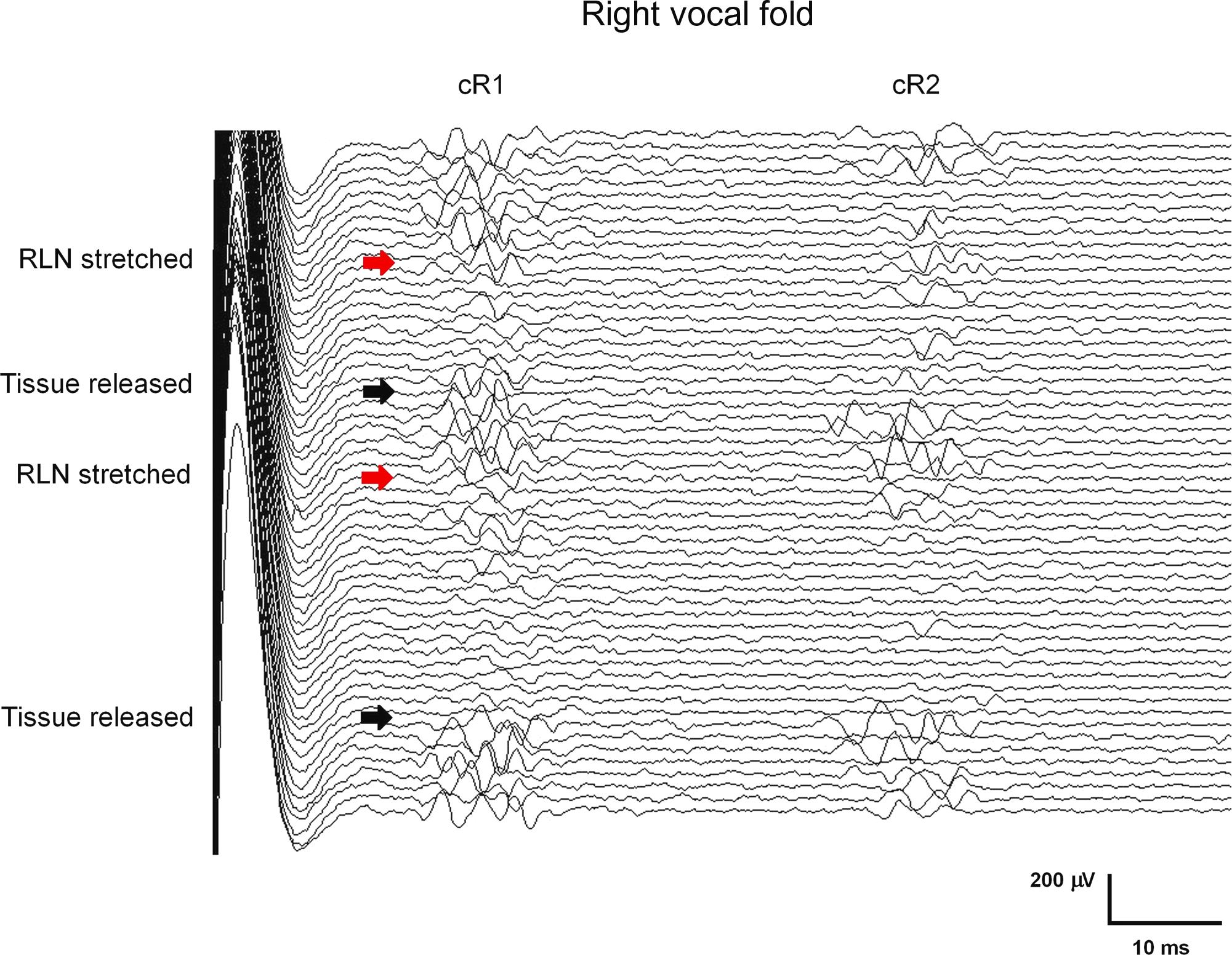
On the contrary, the onset latency of the LAR is highly variable (22.4±2.5 ms) and is not a good parameter to predict nerve injury . In our experience, the cR1 component of the LAR is 100% elicitable before the surgery starts, as long as the anesthesia used is TIVA, the endotracheal tube is placed correctly and have elapsed 10–20 minutes since Succinylcholine administration. However, during surgeries, the ability to record such responses can decrease by approximately 4% of cases due to tube displacement causing decrements in LAR amplitude .
When LAR amplitude decreases during surgery, it is important to consider possible tube displacement as the cause and eliminate this variable by assessing the contralateral LAR, used here as a control. If the decrement is secondary to suboptimal stimulation due to slight tube displacement, by simply increasing the stimulus intensity, the amplitude of the LAR can recover. To confirm that amplitude decrement of the LAR is truly related to nerve stress under a specific surgical maneuver, it is also critical to assess the reversibility of the amplitude after relaxation of the tissue in the surgical bed and use of warm saline irrigation of the surgical field.
Become a Clinical Tree membership for Full access and enjoy Unlimited articles
If you are a member. Log in here